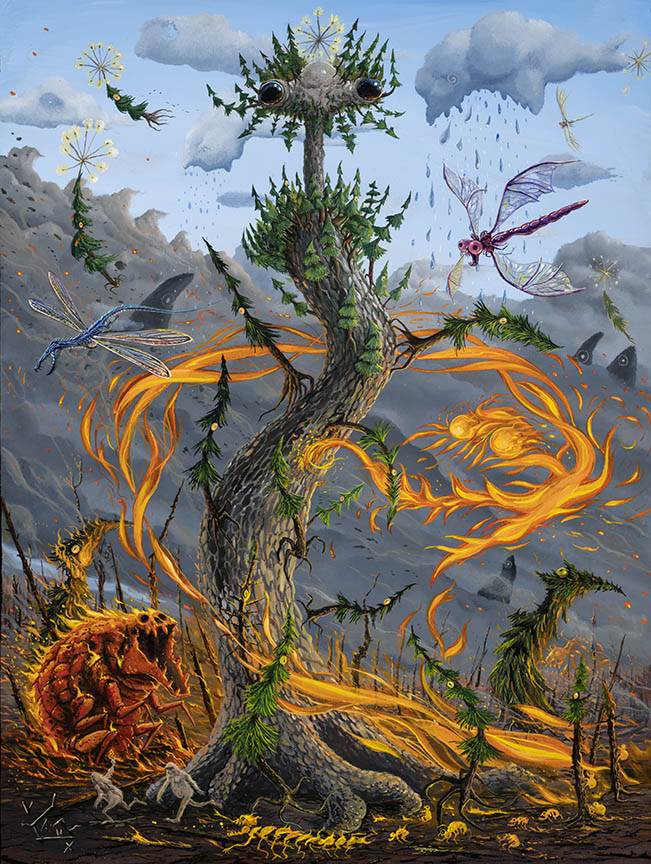
For those in San Francisco, this is your last week to view the merged images of painter Pakayla Biehn‘s solo exhibition at Gallery Hijinks. In this show, Biehn continues the double exposure theme of her previous work, revisiting the cognitive distinction between realism and abstraction. She utilizes the suggestive combination of critical and substantial realism with dream-like transfiguration of the natural world. She displays the unique potential to capture her subjects in inextricable moments that appear to straddle two worlds at once, that in which we exist and another slightly beyond our comprehension. Hi-Fructose caught up with the artist to ask her a few questions about her work and current show, which will be on display until November 5th. – Marisa Ware

To begin with, I’m curious about your process. How much does technology, such as photoshop, play into it? Your work seems like the marrying of old master techniques with a modern edge of image merging. How do you choose what images to use together? Are there certain criteria they have to share, or are you looking more for images with distinct differences?
I’m a big supporter of the marriage of technology and arts. Visual artists have loads of helpful tools at their disposal and should be taking advantage of them, or at least testing the electrified waters. It’s important to shake the stigma of that integration, embrace the inevitable, and live in symbiosis. Artists since the renaissance have been utilizing modern technology to further their careers and abilities, such as the camera lucida and camera obscura. Caravaggio, Vermeer, Ingres, so many more. I’ve been integrating technology into my practice for a while, from the use of photoshop to projection to prints on canvas, but I do have a preferred few. In the incubation stages I use photoshop, whether it be setting the actual composition of two images to make a double exposure or a simple crop and color correct. I also use photoshop’s color picker to find the simplest mixture of color. This is my favorite tool because it makes my colors very clean, no muddiness and almost luminescent.
My image selection process isn’t very esoteric. The most prominent characteristics I search for are beauty and anonymity. I have a proclivity for the lucid and ethereal, but careful to avoid images that appear too gaudy. I try and match images that are diverse but still share a important quality. This formula varies with each painting, so I can’t really pin point any prevalent visual theme.

I think it’s fascinating and inspiring that you turned a physical ailment into something so beautiful. How related do you think your multiple exposure paintings are with the fact that you were diagnosed with strabismus as a baby? I’m sure you get asked questions like that a lot. Do you think that it’s even relevant to your art at this point?
Thank you. Double vision, among other symptoms of Strabismus, have always been this source of self-consciousness and isolation through my adolescence. Adhering the double exposure effect to my work just sort of fell into place when I was work-shopping concepts that dealt with detachment. A bit of this conceptual decision can be attributed to reading about Chuck Close’s disease, Prosopagnosia, or face blindness. In my opinion, he is one of the most prolific portrait artists and to create such a successful career while having a disease where he cannot remember even his closest friends faces was incredibly inspiring.
I try not to be overly precious or sentimental about my work and its relation to my eye condition. In its infancy the concept relied heavily on my vision problems, but as I grew up it began evolving it into something more than overcoming childhood embarrassment and morphed into a deeper symbolism of many things, other paramount dualities.

Your work seems to be communicating something about simultaneousness. Can you tell me more about this? What are you trying to express by portraying two images at once? What do you think the photorealistic element of your work adds to that intent?
Initially the double exposure effect was a direct image of what I experienced, but as I explored the theme more I began to discover a multitude of transcendental issues within the work. Most importantly the passage of time and thought, the eternal and durable, sustainability versus impermanence; these images very much serve as a metaphor for my relationships. Things that are usually, but don’t necessarily have to be, mutually exclusive.
These paintings are already visually confusing and I think that the only honest and clear way to paint them is photorealism. Coming from a mathematics background, I’m most familiar with having a final product known and plugging my variables in to create an equation that is coherent.

Do you plan on continuing to explore your photorealistic double exposure style? Any ideas of what territory you will venture into next?
I absolutely want to continue to explore. This style is definitely still in a nascent stage and needs more cultivating. I’m still marinating some different ideas about where to go next. I’m thinking about pushing myself into a more abstracted sphere, not actual abstract painting, but a bit more painterly, looser. Which, coming from my classically trained background, is quiet difficult for me. I’m certain that if I continue to surround myself with a coterie of creative enthusiasts I’ll find my spark of inspiration.





